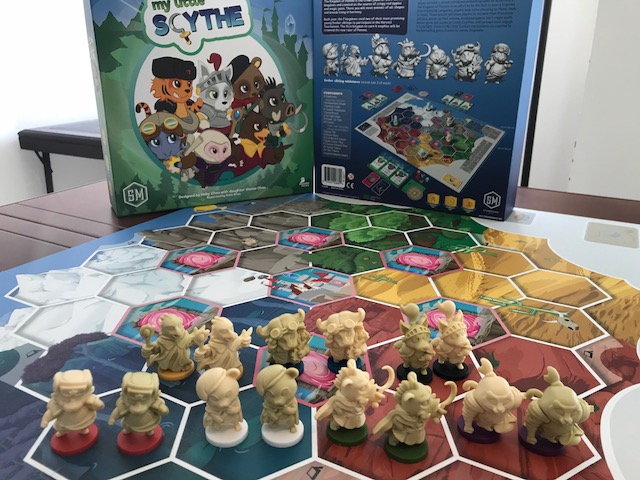My Little Scythe published by Stonemaier Games arrived at the start of last week. After getting to grips with everything and setting up my wife, 7-year-old daughter and 9-year-old son sat down to play. I had already learned the rules and worked out what we had to do and this made teaching the children a lot easier, even so, I was surprised at how incredibly quickly they picked up what to do and, in my 9-year-olds case particularly, how fast he formulated a strategy. Suffice to say my 7-year-old won but our first game was a roaring success and we played twice more that evening.
It’s barely been a week and My Little Scythe has had more table time than any other game in our collection and is definitely a new family favourite.
Having played and enjoyed several games of Scythe since we bought it a few weeks ago we were under the impression that this would be a watered-down and simplified version of another favourite.
We were wrong.
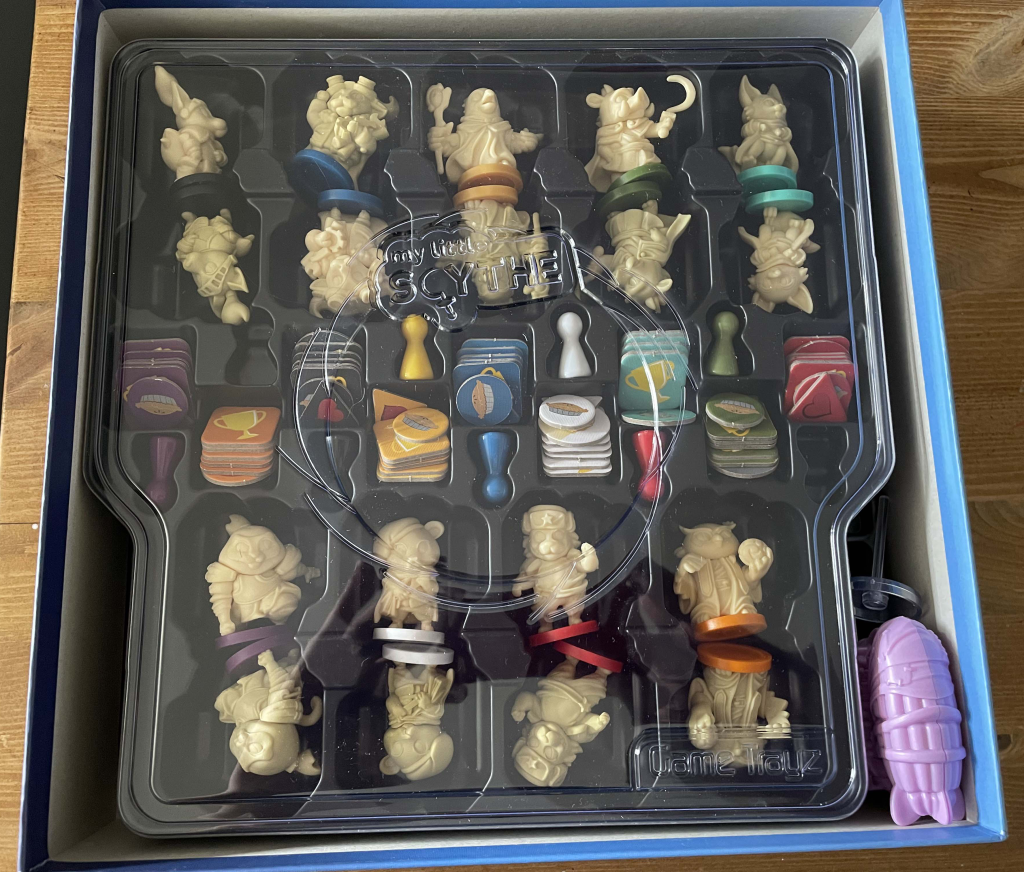
My Little Scythe is pretty cutesy, your characters are little forest animals with happy expressions and instead of dealing with iron or wood etc, you have some pretty little Gems and Apples to take to Castle Everfree at the centre of the board.
The combat is more child friendly and involves you having a pie fight with the aggressor losing a friendship and the loser being sent back to base camp and losing any resources in the tile they have been ousted from. This is possibly the only part of the game that caused my 7-year-old any issue as she didn’t want to give up her pies but also was unhappy if she lost. The same format is used whereby a player gambles how many of their pies they will spend to fight, they add spells and reveal on the count of three, both players lose the number of pies they gambled and the one who spent the most is the victor.
Being returned to home base allows you to gain either 2 pies or a spell card that will help you in a pie fight.
A lot like Scythe in the way each turn plays out you move your player marker to one of 3 areas where you can take one action, which is to Move, Seek or Make.
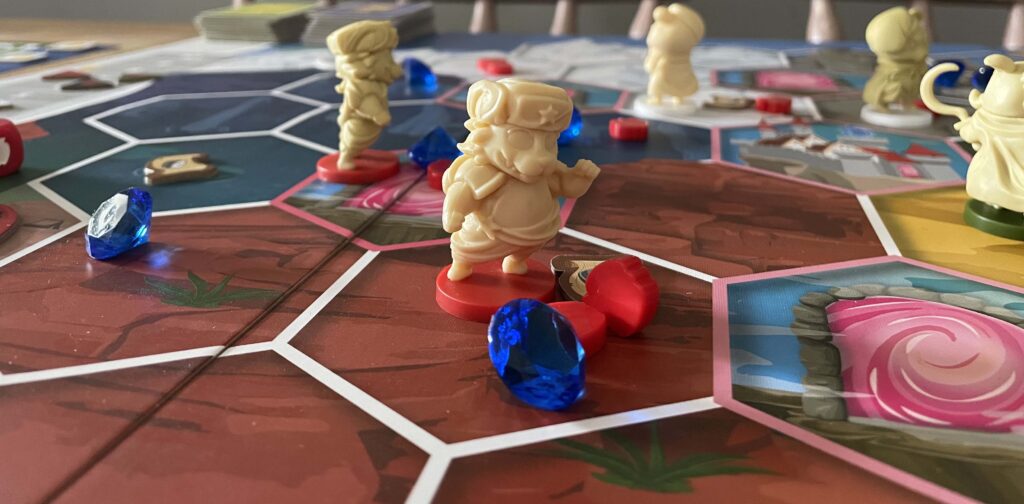
Moving is usually the first action you take in the game and you can move each of your seekers up to two spaces if you are not carrying anything. Whilst carrying an item you can only move one space, however as the game progresses you will have the opportunity to upgrade your movement to be able to move further whilst carrying items.
Moving to Seek you consult your player board and choose to roll a number of dice, you can choose to roll two Gem dice or two Apple Dice and one of the other but always roll a Quest dice. The colour of the icons determining which terrain type you can place your corresponding counters.
If you choose to place an item in a zone controlled by another player you gain a friendship level but if you place them in an area you control there is no corresponding penalty. After you have taken the trophy for reaching 8 friendship there is no reward for helping other players.
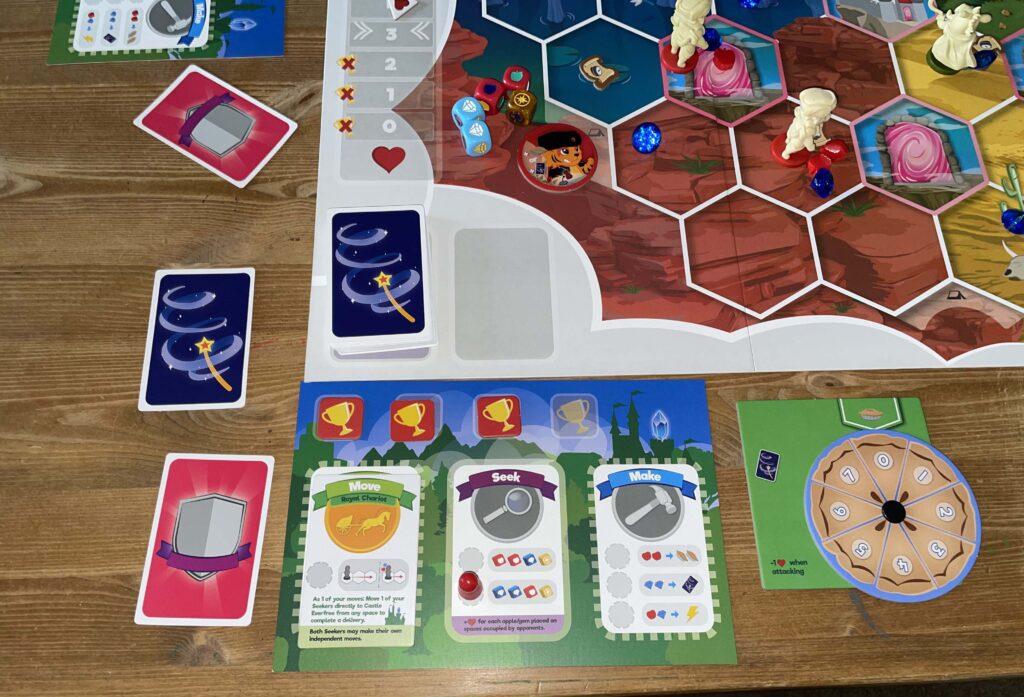
There are portals just like in Scythe and because you cannot actually remove resources off of the board storing them in one place can be a risky strategy as players are never far from you looking for a pie fight. Another mechanic which makes things easier and less competitive is that Castle Everfree is also considered a portal space so you can make a delivery of 4 gems or 4 apples quite quickly, gaining two trophies in the process and as it’s the only time you can enter the castle space and lends to the friendly nature of the game overall as players don’t need to fight over resources as much as you first might think.
I will briefly touch on your secret quest here because it could be considered relevant. At the start of the game each player is dealt a secret objective, achieve it and you will be able to place a trophy. Taking three resources to Castle Everfree instead of four or only needing 7 pies instead of 8 could give you a trophy but this was something my daughter often forgot about so we read her card with her and reminded her when necessary.
At the end of your movement turn if you are in a space with a Quest token you must look at the quest card. This will involve three options, the top two often include a penalty but if you have two completed quest cards you can place a trophy, the bottom option just says “No thanks”. This last option will allow you to move up the friendship or pie tracker.
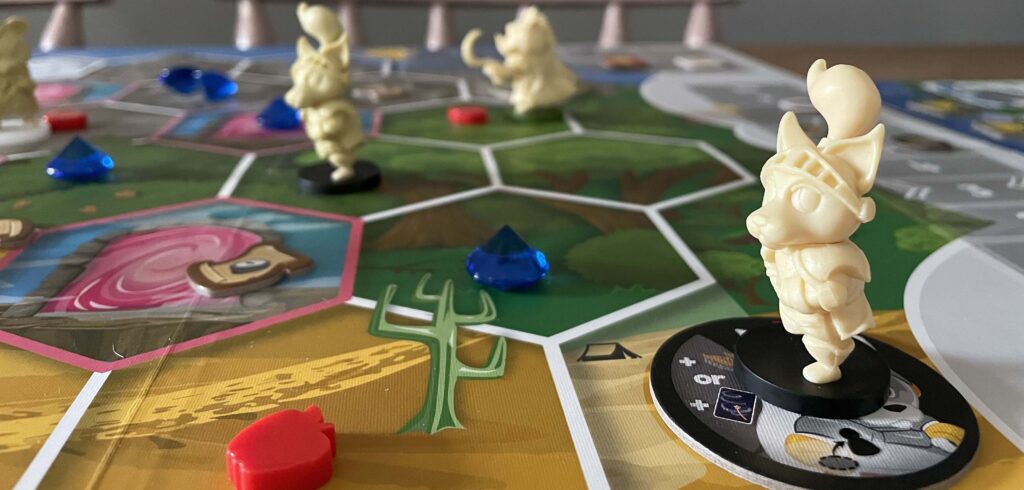
The last action you can take is to Make. Here you can increase the number of pies you have, create spell cards that allow you a certain number of extra pies for a fight or you can upgrade. Paying one apple and one gem from spaces you control you can upgrade either movement or Make segments of your player board usually meaning you can move further or create more components. Again, upgrading both of these will let you place a trophy.
The pace of the game is perfect for playing with children, turns happen quickly and whilst there is strategy involved you are not really competing with the other players for resources as they are replenished very quickly. The competition comes from placing the four trophies first, you can gain a trophy in so many different ways that you don’t need to worry about what someone else is doing, having only played with four players, I can say we all focussed on getting our trophies and not sabotaging each other. It may be that we are a mother and father playing with children or, more likely, by design that the game is a competition without being competitive.
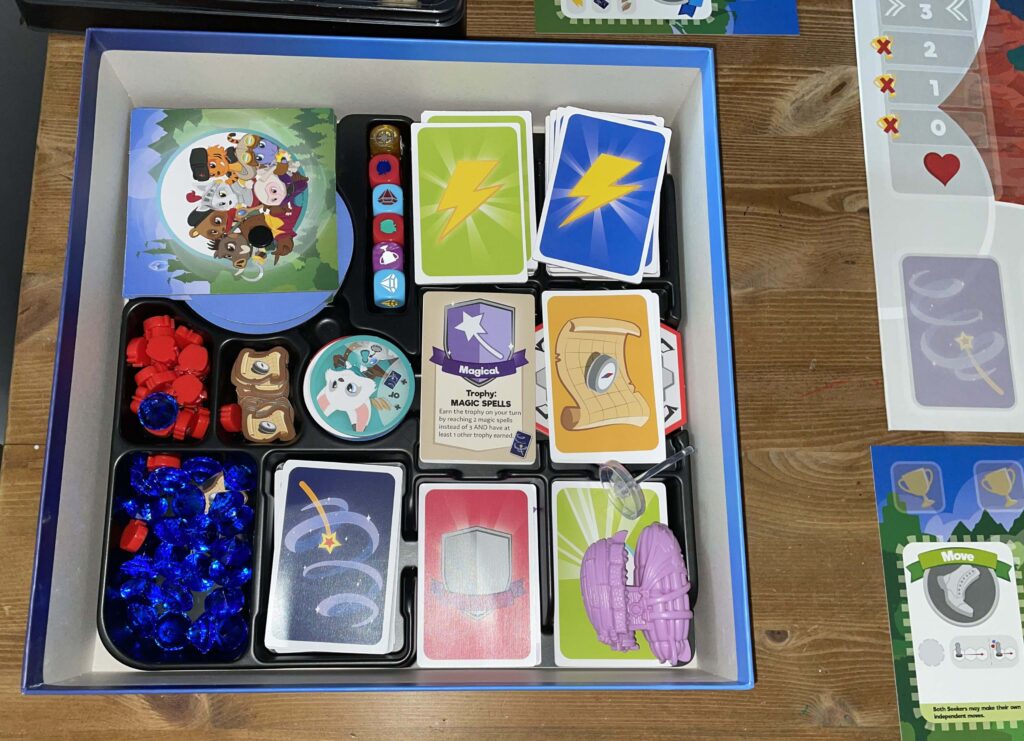
The game was actually designed by Hoby Chou and his 9-year-old daughter Vienna. He wanted to create a version of Scythe that was accessible and appealing to children and I think they have achieved exactly that.
Being published by Stonemaier Games the quality of the components is second to none, set up is quick but even better than this, break down is fabulously easy with everything having a specific place to go in the box, it’s like it came with a custom insert.
The back story of My Little Scythe is that the winner of the competition will rule over Pomme for the next year but we soon forgot this, as winning isn’t the important thing when playing with children. For us at least, sitting at a table together, away from TVs, iPads and Phones is one of the best ways to spend time with our children and one of the most pleasurable things to do as a family.
We were sent My Little Scythe and the Pie in the Sky expansion for free but this has in no way changed the way I approached this review and in fact, makes me look deeper into a game than I normally would. My family love My Little Scythe, it’s definitely something for non-board games obsessed families to look at.
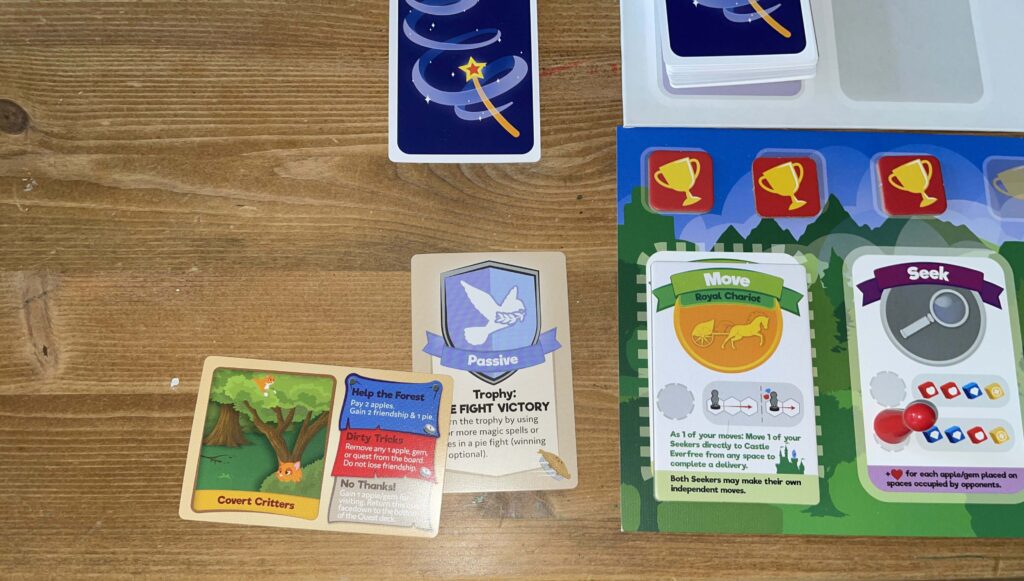
If you are a family who only sits together at Christmas and play Monopoly then you are really missing out. In the UK you can pick up My Little Scythe for around £30, Monopoly and similarly popular titles are selling for the same price but I can promise you that My Little Scythe will spend more time on the table because you will want to play it.
We have had a copy of Monopoly for 20 years and I can honestly say that my wife and I played one game when we bought it, and it has been played fully about 3 times since.
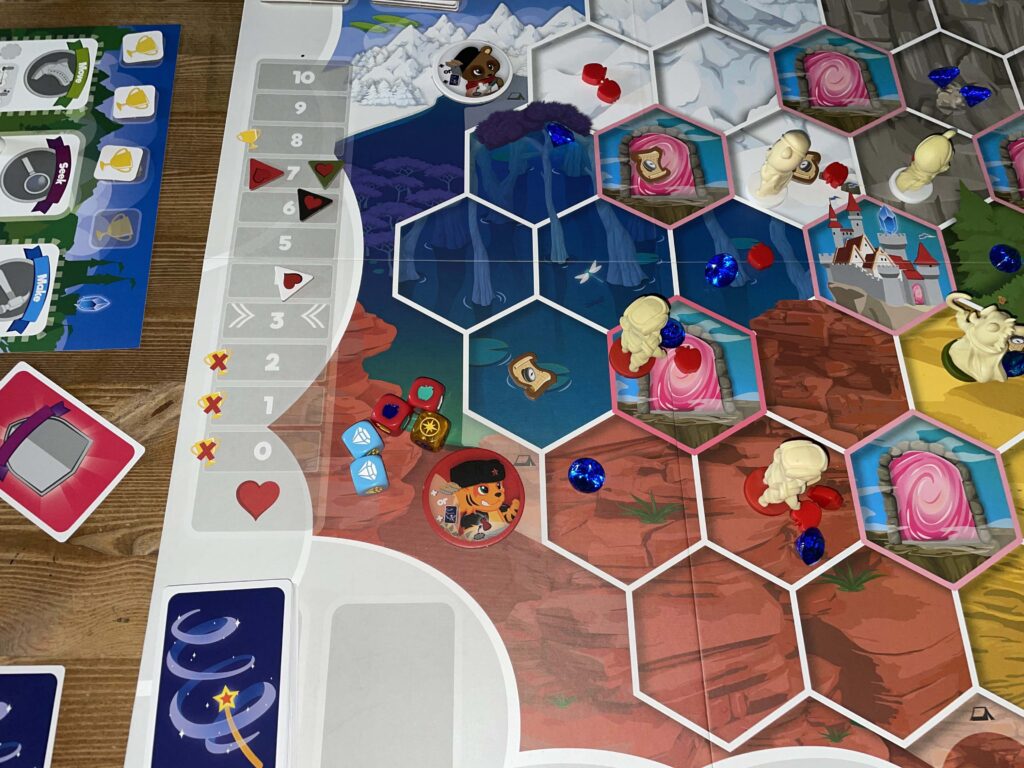
In Summary
My Little Scythe is just about as good a family game as you can buy. Our longest game was under an hour and our shortest about 40 minutes. The rules are simple for children to understand and it remains fun whilst not being competitive. There could be a little more for adults to do but I wouldn’t recommend playing this with just adults as the depth isn’t there, however, there are still times when you have to make decisions and think ahead but there is no real consternation for an adult. If you have children then My Little Scythe should be in your game library so stop reading about it and go buy it now.

